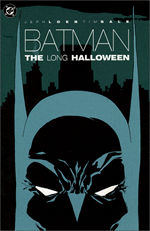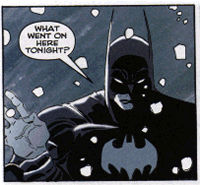>> The Friday Review: Zero Girl
>> The Friday Review: Ruse: Enter The Detective
More...

 Writer: Jeph Loeb
Writer: Jeph Loeb
Artist: Tim Sale
Colourist: Gregory Wright
Letterer: Richard Starkings & Comicraft
Collecting BATMAN: THE LONG HALLOWEEN #1-13
Price: $19.95
Publisher: DC Comics
ISBN: 1-56389-427-0
When I first started reading comics, at the age of about nine or ten, I never noticed the art. Readers would comment in the various letter pages of my favourite comics at the time (CAPTAIN AMERICA, AVENGERS and SPIDER-MAN, for the record) on what they liked or didn't about different artists, and I would have no idea what they were talking about. So bad was my affliction that, when an artist would change on my favourite book, or when someone would do a fill-in issue, I wouldn't even notice. Which makes it all the more ironic how much the art can influence my enjoyment of a book today.
Which brings me to BATMAN: THE LONG HALLOWEEN. Of course, the book has something obvious to recommend it at this time of the year; it's kind of like recommending A CHRISTMAS CAROL at Christmas time - a no-brainer. Yet the book offers much more to the reader than mere happy seasonal convergence. And among the many pleasures it does offer, I'd have to rank Tim Sale's masterful artwork first.
Make no mistake; Jeph Loeb has crafted an intricately plotted tale with a fine sense of pacing that is full of spot-on characterisation for what seems like 90% of the Batman cast. It is an extremely well written book. But, for me, it is the quality of Sale's artwork that gives it that final push toward greatness.
But I get ahead of myself. BATMAN: THE LONG HALLOWEEN tells a tale, set during Batman's early years, of a serial killer at loose in Gotham City; a killer whose modus operandi has branded him Holiday. Beginning on Halloween, and once a month thereafter, on that month's most prominent holiday, he murders a member of Gotham City's most powerful crime family, the Falcones, leaving behind a cheap souvenir emblematic of that holiday as a kind of calling card.
The book is formatted as a murder mystery, with Batman, after all the World's Greatest Detective, attempting to discover the identity of the killer, while also dealing with the activities of his regular rogues gallery. Into this heady stew, Loeb throws in a very effective retelling of the origin of Two-Face.
What made THE LONG HALLOWEEN particularly appropriate, upon its original publication, was its monthly schema. For once, readers along for the ride from the beginning actually had a natural and compelling reason, story-wise, to be forced to wait a month between issues. Each issue highlighted Holiday's attack for that month. That is, in the November issue, we saw Holiday attack on Thanksgiving. The December issue detailed a Christmas slaying. And so on. So, in the world of the story, Batman was forced to wait a month between issues, just as we were. For once, a mini-series that was published over the course of a year told a story that took a year as well.
'Sale achieves a precarious balance between realism and caricature.' Of course, this is a review of the trade paperback, and one can now read the whole thing in one sitting. This is, in fact, the way I came to the story, and, wonderful as that monthly device was, the story loses none of its impact in a collected volume. And the advantage that the collected version offers should be clear; just as in a traditional mystery novel, Sale leaves the reader clues to follow, and encourages readers to attempt to deduce the identity of the killer before Batman can. With the series collected, the challenge of remembering and connecting seemingly insignificant details from month to month is eliminated.
But again, all this storytelling cleverness is just the icing on the cake of Sale's artwork. The art in THE LONG HALLOWEEN is nothing short of stunning. The book can be a quick read, largely due to Sale's liberal use of big panels and splash pages. Where for other artists the use of these big, show-offy images might be gratuitous, Sale wields the technique without a misstep. The images he chooses to blow up are not only beautiful and full of detail, but also consistently appropriate to the story.
Just paging through at random, I find a splash taking up a full two-thirds of a two-page spread. We are in the Dent basement, and Sale has captured exactly what such a basement might look like. Jars and boxes are stacked on shelves, an old rusty boiler takes up a corner, calendar pages are stuck to the wall. But, more importantly, we get a real sense of Sale's supreme storytelling ability. Here we have a splash page with no one in costume and with no action at all, just Harvey talking to his wife, Gilda. But the moment is an emotionally strong one, and important to the story, and, by sheer virtue of scale, Sale calls our attention to it.
His depiction of the characters themselves is Sale's other grand achievement. He has somehow managed to achieve a precarious balance between the disparate realms of realism and cartoon-like caricature. For example, I remember revisiting the book one afternoon, and as I paged through I went looking for the Joker, remembering how impressed I was with Sale's realistic rendition of the character.
 But, as I discovered, my memory had been fooled. Sale's Joker - indeed, all of Sale's characters - are not rendered realistically. Witness the Joker's pencil-thin-nose, impossibly large jaw and six-inch-long, chopstick-thin yellow teeth. Through pitch-perfect styling, Sale manages this neat trick of "realistic caricature" achieving the illusion of reality through exaggeration.
But, as I discovered, my memory had been fooled. Sale's Joker - indeed, all of Sale's characters - are not rendered realistically. Witness the Joker's pencil-thin-nose, impossibly large jaw and six-inch-long, chopstick-thin yellow teeth. Through pitch-perfect styling, Sale manages this neat trick of "realistic caricature" achieving the illusion of reality through exaggeration.
Attention should also be paid to the colouring by Gregory Wright. Colour is used effectively throughout the book, whether it be in the muted, grey tones that accompany scenes set at night or the sepia tinge that washes over the flashbacks. In several instances, the colour is also used in a highly theatrical way. Witness the scene in which a man is found dead in a dark bathroom lit only by the light coming in through a half open door. The contrast between the pure black and white tones used on the majority of the page and the pure red of the bath water is perfect. Sale and Wright have created a beautiful book, supreme in its quality of detail and sense of pacing.
The softcover edition of the book contains five pages of extras in the back: a page detailing the Falcone family crime empire, and four pages of "cut" scenes that, while interesting, are not essential additions to the story. Loeb himself writes the informative and warm introduction. Since THE LONG HALLOWEEN, the team of Loeb and Sale has made, a career of working together, and all of their collaborations thus far - SUPERMAN: A MAN FOR ALL SEASONS, BATMAN: DARK VICTORY and the currently ongoing DAREDEVIL: YELLOW - come, more or less equally, highly recommended.
I will attach one caveat to this otherwise rhapsodic review. The story is, at the end of the day, a murder mystery, and this particular mystery ends on a somewhat ambiguous note. Mystery fans who like their mysteries cleanly and completely tied up in a neat bow at the end, with all explained, might come away somewhat disappointed. But, for all else, this is a must-read, in every sense of the word.

This article is Ideological Freeware. The author grants permission for its reproduction and redistribution by private individuals on condition that the author and source of the article are clearly shown, no charge is made, and the whole article is reproduced intact, including this notice.


